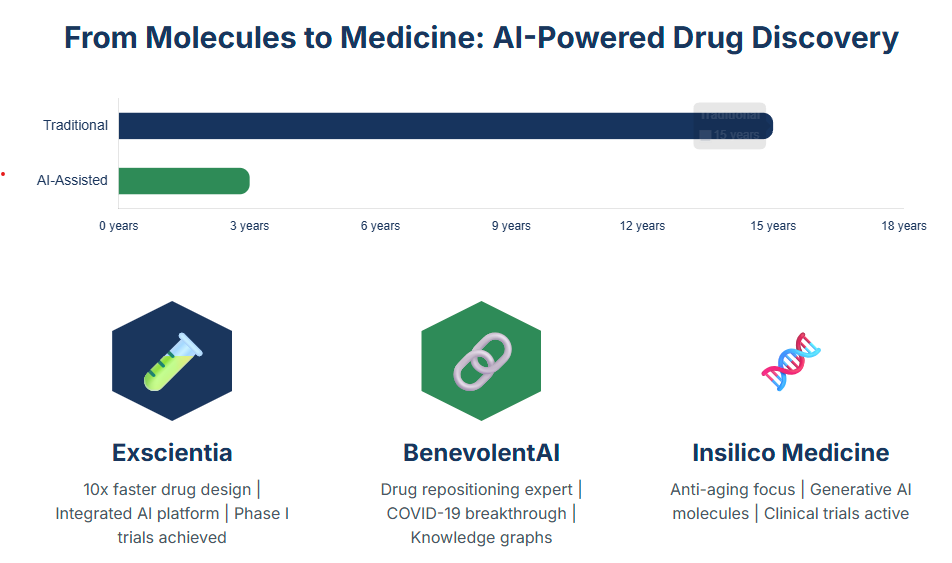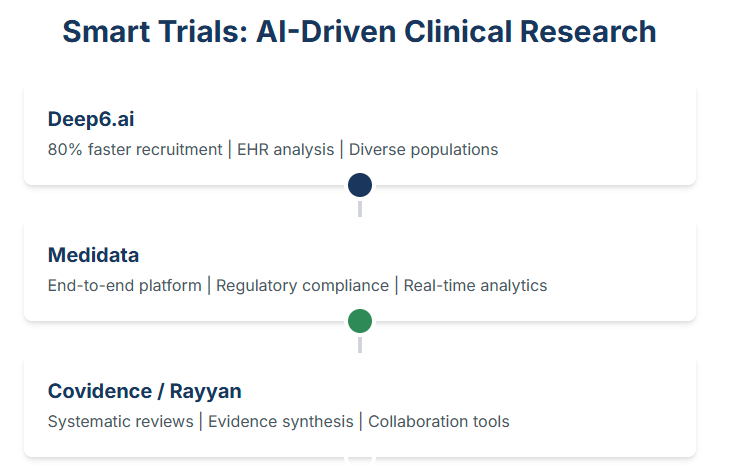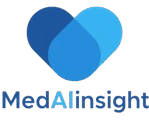AI Toolkit in Healthcare is revolutionizing medical research—discover game-changing tools from drug discovery to diagnostics replacing outdated methods.
The Medical Research Renaissance You’re Missing
Picture this: while your colleague spends three months manually screening compounds for a potential breakthrough, across the corridor, another researcher has already identified, designed, and validated a promising drug candidate—all before lunch. The difference? One embraces artificial intelligence, the other clings to methodologies that would make Alexander Fleming feel nostalgic.
This isn’t science fiction. It’s the stark reality of medical research in 2025, where the integration of AI with big data and omics technologies is reshaping the global drug discovery market, enabling a deeper understanding of biological systems, improving efficiency, and driving personalized medicine. Yet remarkably, countless laboratories worldwide continue operating as if the digital revolution never happened.
The question isn’t whether AI will transform medical research—it already has. The question is whether you’ll be leading this transformation or watching it from the sidelines, wondering why your peers are publishing breakthrough papers while you’re still parsing through endless literature manually.
This comprehensive guide dissects the AI tools that are redefining medical research across every domain, from molecule design to clinical trial management. More importantly, it reveals why adopting these technologies isn’t just about efficiency—it’s about fundamentally reimagining how we approach human health challenges.
From Serendipity to Science: How AI Transforms Drug Discovery
Traditional drug discovery resembles a medieval alchemist’s workshop: expensive, time-consuming, and relying heavily on chance. The statistics are sobering—developing a single drug costs approximately $2.6 billion and takes 10-15 years, with a 90% failure rate. This model isn’t just inefficient; it’s ethically questionable when patients with rare diseases wait decades for treatments that could be discovered in months.
Leading startups like Atomwise, BenevolentAI, Exscientia, Insilico Medicine, and Recursion Pharmaceuticals are offering specialized AI platforms, fundamentally disrupting this antiquated approach. These aren’t incremental improvements—they represent a paradigm shift from trial-and-error methodology to precision-guided molecular engineering.

Exscientia stands as the poster child of this revolution. Their integrated platform doesn’t just accelerate drug design; it reimagines the entire process. The Oxford-based company has one of the most mature AI-focused drug discovery pipelines and entered phase I trials in May, proving that AI-designed molecules can transition from concept to human testing with unprecedented speed. Their approach combines machine learning algorithms with human creativity, creating a symbiotic relationship that amplifies both computational power and scientific intuition.
What makes Exscientia particularly compelling isn’t just their technology—it’s their philosophy. They recognize that AI shouldn’t replace human researchers but augment their capabilities, handling the computational heavy lifting while humans focus on strategic decision-making and creative problem-solving.
BenevolentAI takes a different yet equally revolutionary approach: drug repositioning powered by knowledge graphs. Their platform essentially creates a digital twin of biomedical knowledge, identifying unexpected connections between existing drugs and new therapeutic applications. Their COVID-19 work with baricitinib exemplifies this approach’s power—what traditional research might have taken years to discover, BenevolentAI identified in weeks by analyzing vast networks of biomedical relationships.
This isn’t mere data mining; it’s knowledge archaeology, unearthing buried connections in the vast landscape of medical literature and molecular databases. BenevolentAI’s approach suggests that our current pharmaceutical arsenal might contain numerous hidden therapeutic gems, waiting for AI to reveal their potential.
Insilico Medicine pushes the boundaries even further with their focus on aging research and generative AI. Their unique generative adversarial network (GAN)-based approach synthesizes new drugs for individual diseases, with GANs functioning by discovering patterns in input data to generate new samples that could have plausibly been drawn from the original dataset. This represents molecular creativity at its finest—AI systems that don’t just analyze existing compounds but imagine entirely new ones.
Their aging-focused approach addresses one of humanity’s most fundamental challenges. While traditional pharmaceutical companies might view aging as an inevitable biological process, Insilico Medicine treats it as a disease to be cured, using AI to identify intervention points that could extend healthy human lifespan.
The implications extend far beyond individual companies. We’re witnessing the emergence of a new scientific method where hypothesis generation, experimental design, and result interpretation become collaborative processes between human intelligence and artificial systems. This partnership doesn’t diminish human researchers’ role; it elevates it, freeing them from routine computational tasks to focus on strategic thinking and creative problem-solving.
The Diagnostic Revolution: When Machines See What Humans Miss
Medical imaging has always been part art, part science. Radiologists train for years to develop the pattern recognition skills necessary to spot subtle abnormalities in complex images. Yet even the most experienced human eye can miss early-stage cancers, misinterpret ambiguous shadows, or succumb to fatigue after analyzing hundreds of scans.
AI doesn’t get tired. It doesn’t have bad days. And increasingly, it doesn’t make the same mistakes humans do.
Paige.AI represents the cutting edge of pathological analysis, transforming how we approach cancer diagnosis. Their platform doesn’t merely assist pathologists—it augments their capabilities, identifying cellular abnormalities with superhuman precision. The implications are profound: faster diagnoses, reduced human error, and most importantly, earlier cancer detection when treatment is most effective.
What sets Paige.AI apart isn’t just their accuracy—it’s their approach to human-AI collaboration. Rather than positioning their technology as a replacement for pathologists, they’ve designed it as an intelligent assistant that highlights areas of concern, suggests differential diagnoses, and provides evidence-based support for clinical decisions. This collaborative model addresses a crucial concern in medical AI: maintaining human judgment and responsibility while leveraging computational advantages.
Arterys tackles a different challenge: the complexity of multi-modal imaging analysis. Modern medicine generates vast amounts of imaging data across multiple modalities—MRI, CT, ultrasound, and more. Traditionally, each requires specialized expertise and separate analysis workflows. Arterys’ cloud-based platform unifies this process, enabling comprehensive analysis across imaging types while improving workflow efficiency.
Their cloud-based approach addresses a critical infrastructure challenge facing healthcare institutions. Not every hospital can afford cutting-edge AI hardware or employ teams of AI specialists. By providing sophisticated imaging AI through cloud services, Arterys democratizes access to advanced diagnostic capabilities, potentially reducing healthcare disparities between well-funded academic centers and resource-constrained community hospitals.
Enlitic pursues perhaps the most ambitious vision: predictive healthcare through imaging fusion. By combining imaging data with clinical information, their platform doesn’t just diagnose current conditions—it predicts future health risks, enabling proactive rather than reactive healthcare. This represents a fundamental shift from treating diseases to preventing them, from reactive medicine to predictive healthcare.
The broader implications of AI-powered imaging extend beyond individual diagnostic improvements. We’re moving toward a future where medical imaging becomes a window into personalized health trajectories, where AI systems can identify disease patterns years before symptoms appear, and where treatment planning becomes increasingly personalized based on individual imaging signatures.
Consider the societal impact: if AI can reliably detect cancer at Stage 0, before it becomes invasive, we might fundamentally alter oncology’s treatment paradigm. Instead of aggressive chemotherapy and radiation, we might prevent cancers before they become life-threatening. This isn’t just technological progress—it’s a potential transformation in human health outcomes.
Reimagining Clinical Research: From Administrative Burden to Strategic Focus
Clinical trials represent medicine’s necessary evil: essential for proving treatment efficacy and safety, yet plagued by inefficiencies that delay life-saving therapies. Traditional trial management resembles conducting an orchestra while blindfolded—researchers struggle to recruit appropriate patients, monitor compliance, ensure regulatory adherence, and extract meaningful insights from complex data sets.
AI transforms this cacophony into a symphony of coordinated efficiency.

Deep6.ai addresses perhaps the most critical bottleneck in clinical research: patient recruitment. Traditional methods rely on manual chart review, a process so inefficient that studies suggest up to 80% of clinical trials fail to meet enrollment goals on time. Deep6.ai’s platform analyzes electronic health records with surgical precision, identifying patients who match complex trial criteria in minutes rather than months.
But the true innovation isn’t just speed—it’s inclusivity. Traditional recruitment methods often introduce unconscious biases, inadvertently excluding certain populations from clinical research. AI-powered recruitment can identify diverse patient populations more systematically, potentially addressing the historical problem of clinical trials lacking representative diversity.
Medidata takes a comprehensive approach to trial management, creating integrated platforms that handle everything from protocol design to regulatory submission. Their analytics capabilities transform trial data from static reports into dynamic insights, enabling real-time course corrections and predictive modeling.
What makes Medidata particularly valuable isn’t their individual features but their systems thinking approach. They recognize that clinical trials are complex ecosystems where seemingly minor inefficiencies can cascade into major delays. By optimizing the entire workflow rather than individual components, they create synergistic improvements that exceed the sum of their parts.
Covidence and Rayyan address a different but equally crucial challenge: evidence synthesis. Systematic reviews and meta-analyses form the backbone of evidence-based medicine, yet traditional approaches to literature review are painfully slow and prone to human error. These platforms accelerate systematic reviews while improving methodological rigor, enabling researchers to synthesize evidence more quickly and comprehensively.
The broader implications extend beyond individual studies. As the medical literature grows exponentially, traditional review methods become increasingly inadequate. AI-powered synthesis tools don’t just save time—they make comprehensive evidence synthesis possible at scales previously unimaginable.
Consider the potential impact on medical guideline development. Professional societies could update treatment recommendations more frequently based on continuously updated evidence synthesis, ensuring that clinical practice reflects the latest research findings rather than lagging behind by years.
The Scholar’s AI Arsenal: Transforming Research and Writing
Academic medicine has always been a peculiar blend of cutting-edge science and medieval bureaucracy. Researchers who manipulate genes and design molecules still spend countless hours on literature searches that would have challenged scholars in Alexandria’s ancient library. The writing process remains largely unchanged since Gutenberg, despite the exponential growth in medical knowledge.
This disconnect between technological capability and academic practice borders on the absurd.

Scite represents a fundamental reimagining of citation analysis. Traditional citation counts treat all citations equally—a paper disputing another study’s findings receives the same weight as one confirming its results. Scite’s platform analyzes whether citations support, contradict, or merely mention previous work, providing a nuanced understanding of research consensus and controversy.
This seemingly simple innovation has profound implications for research integrity and knowledge synthesis. Researchers can quickly identify which findings have strong supporting evidence versus those that remain controversial. Literature reviews become more sophisticated, distinguishing between well-established facts and preliminary findings that require further validation.
Scholarcy addresses the information overload challenge facing modern researchers. With over 2 million new papers published annually in biomedical fields, comprehensive literature review becomes practically impossible using traditional methods. Scholarcy’s automated summarization doesn’t replace careful reading but enables efficient triage, helping researchers identify which papers deserve detailed attention.
The platform’s strength lies in its understanding of academic writing conventions. Unlike general-purpose summarization tools, Scholarcy recognizes the structure of scientific papers, extracting key findings, methodological details, and limitations with remarkable accuracy.
ResearchRabbit takes a network approach to literature discovery, visualizing the complex relationships between papers, authors, and research topics. This isn’t merely a fancy citation map—it’s a research navigation system that reveals hidden connections and emerging trends that traditional search methods might miss.
The platform’s visual approach appeals to researchers who think spatially about knowledge domains. By representing literature as interconnected networks rather than linear lists, ResearchRabbit enables intuitive exploration of research landscapes and serendipitous discovery of relevant work.
Keenious focuses on integration, embedding AI-powered literature discovery directly into writing workflows. Their Word and Google Docs plugins suggest relevant articles based on the text being written, turning literature review from a separate preliminary phase into an integrated aspect of the writing process.
This workflow integration addresses a common problem in academic writing: the disconnect between initial literature searches and the evolving focus of research projects. As papers develop, new citations become relevant, but traditional search methods make it difficult to identify these connections without interrupting the writing flow.
The collective impact of these tools extends beyond individual productivity improvements. They’re reshaping how knowledge flows through the academic ecosystem, potentially accelerating the pace of scientific progress by reducing the friction between idea generation and literature synthesis.
The Future Is Already Here—But Unevenly Distributed
Microsoft recently announced its Dragon Copilot, an AI healthcare tool that can listen to and create notes on clinical consultations, while Google already has a suite of AI models specifically tailored to alleviate administrative burdens in healthcare. These developments signal a broader trend: the convergence of general-purpose AI capabilities with domain-specific medical applications.
We’re approaching an inflection point where AI transforms from a specialized tool used by early adopters to an integral component of all medical research. In biomedical research and drug development, AI could design new molecules, predict how these molecules interact with biological systems, and match treatments to patients with greater accuracy by integrating information across genetics, proteins, all the way to clinical outcomes.
This integration represents more than technological advancement—it’s a fundamental shift in how we conceptualize medical research. Instead of isolated studies investigating specific questions, we’re moving toward interconnected research ecosystems where AI continuously synthesizes findings across disciplines, identifying patterns and connections that individual researchers might miss.
The democratization of AI tools also promises to reduce research inequality. Previously, only well-funded institutions could afford advanced computational resources and specialized expertise. Cloud-based AI platforms make sophisticated analytical capabilities accessible to researchers regardless of institutional resources, potentially leveling the research playing field and accelerating global health innovation.
Yet challenges remain. AI systems are only as good as their training data, and medical research has historically excluded certain populations from studies. If we’re not careful, AI could perpetuate or amplify existing healthcare disparities by training on biased datasets.
Privacy and regulatory concerns also loom large. As AI systems become more sophisticated, they require access to increasingly sensitive health data. Balancing the benefits of AI-powered research with patient privacy and data security will require careful navigation of complex ethical and regulatory landscapes.
The Choice That Defines Medical Research’s Next Decade
Standing at this technological crossroads, medical researchers face a defining choice: embrace AI as a collaborative partner or risk obsolescence by clinging to traditional methods. This isn’t hyperbole—it’s the logical consequence of exponential technological advancement colliding with the conservative culture of academic medicine.
The researchers who thrive in the coming decade won’t be those who can use AI tools—they’ll be those who can think symbiotically with AI, leveraging computational power while maintaining human creativity and judgment. They’ll understand that AI doesn’t replace scientific rigor but enhances it, enabling more sophisticated hypotheses, more comprehensive data analysis, and more rapid iteration through the research cycle.
The tools detailed in this guide represent more than software platforms—they’re the building blocks of a new scientific method. Drug discovery platforms like Exscientia, BenevolentAI, and Insilico Medicine are pioneering molecular design approaches that could eliminate the inefficiencies that have plagued pharmaceutical development for decades. Diagnostic tools like Paige.AI, Arterys, and Enlitic are enabling earlier, more accurate disease detection that could fundamentally alter treatment outcomes. Clinical research platforms are transforming the trial process from a bureaucratic nightmare into an efficient discovery engine.
Perhaps most importantly, these tools are democratizing access to advanced research capabilities. Small laboratories can now access computational power that previously required institutional supercomputers. Independent researchers can conduct literature reviews with the comprehensiveness previously available only to large teams. This democratization could accelerate medical breakthroughs by enabling contributions from a broader community of researchers worldwide.
The question isn’t whether these tools will transform medical research—they already are. The question is whether you’ll be part of this transformation or a bystander watching it unfold. The choice you make today will determine not just your research productivity but your relevance in tomorrow’s medical research landscape.
The future of medical research isn’t just about artificial intelligence—it’s about intelligent collaboration between humans and machines, each contributing their unique strengths to solve humanity’s most pressing health challenges. This future is already emerging in laboratories worldwide. The only question remaining is whether you’ll help shape it or struggle to catch up.
Ready to revolutionize your research approach? Which of these AI tools resonates most with your current research challenges? Share your experiences or questions about implementing AI in medical research—the conversation about our field’s future starts with acknowledging where we are today.
Recommended Reading:
- Artificial Intelligence in Drug Discovery: Revolutionizing Healthcare – A comprehensive guide to AI applications in pharmaceutical research
Disclaimer: This educational content was developed with AI assistance by a physician. It is intended for informational purposes only and does not replace professional medical advice. Always consult a qualified healthcare professional for personalized guidance. The information provided is valid as of the date indicated at the end of the article.

Comments